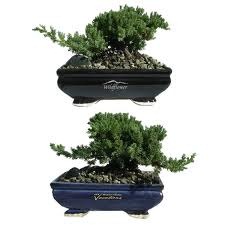The cascade style is among the more beautiful and desirable among bonsai trees, but also more difficult to achieve. The trunk grows down below the level of the container, often twisting as it does so.
In nature, a tree growing near a cliff subject to heavy snows, avalanches and wind may assume this inverted position. Those forces are not generally available to the bonsai artist to imitate, however. Nevertheless, with wiring and patience it can be accomplished.
To remove obstacles from growth in this direction, it’s important that the bonsai tree and pot be placed near the edge of a table or bench so the trunk can hang below the horizontal. Also, since the trunk will be on the side and below, it’s important to use a heavy pot for stability.
As the trunk is encouraged to grow in the downward U-shape, branches should be trained to sprout horizontally to give the bonsai trees a full appearance. Planting directly in the center, not near the edge of the pot, is standard practice.
Often indoor bonsai trees will be trained to grow up and over, rather than simply over the edge. This gives a flow to the look and is accompanied by a tip that resides directly above the center. Branches should be trimmed to create a ‘stair-step’ pattern to complement the cascade and give it a ‘meandering river’ look.
Since the trunk and several branches of the bonsai tree will reside below the pot, extra care is required to ensure that all receive adequate water and nutrients. Foliar feeding (applying fertilizer solution by spraying leaves or needles, which is then absorbed by the foliage) is recommended.
Han-Kengai (Semi-cascade)
Another styleof bonsai trees, han-kengai (semi-cascade) is often categorized separately. In this case, the cascade projects over the horizontal plane at the base of the pot, but neither the trunk nor branches grow below that level. In the semi-cascade style, the tip remains above the level of the ‘ground’.
The category is not sharply defined, since some han-kengai will have portions that are below ‘ground level’, while others will project out horizontally. In either case they retain the curving trunk style common to both the kengai and han-kengai styles of bonsai trees.
As with any style, using the proper species of bonsai trees for your envisioned design is imperative. Fortunately in the case of the kengai and han-kengai, many will serve. Junipers are a popular choice, but flowering cherry trees are also used. Even cedars are used, where the flexible wood makes them an accommodating partner in the project. Some flowering species are used, such as chrysanthemums. ‘Weeping’ species are also good choices, such as willows.
As with the kengai, it’s important to ensure that the slow-moving nutrients make it to the tips of the bonsai trees. Foliar feeding is easily accomplished but needs to be done regularly as part of the watering and feeding practice.


Deprecated: strpos(): Passing null to parameter #1 ($haystack) of type string is deprecated in /home/agriviek8Qv/agriviet.net/public_html/wp-includes/comment-template.php on line 2522